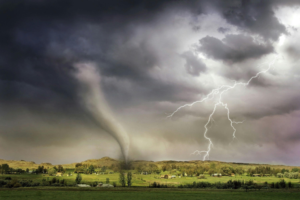The natural world is full of awe-inspiring events, some beautiful and beguiling, others dangerous and destructive.
Among these, nothing portrays both aspects more strikingly than severe weather phenomena.
Today, we dive headlong into the turbulent world of tornadoes and cyclones, two titans of tempests often confused but fundamentally different.
Prepare to join us on a whirlwind tour of these stormy siblings!
What are Tornadoes?
Tornadoes, often referred to as twisters, are violent and unpredictable weather phenomena.
Known for their trademark funnel shape, they are capable of causing significant damage due to the high wind speeds involved and their sudden, unpredictable occurrences.

The Formation Process
The birth of a tornado is a complex process, arising from severe thunderstorms.
A combination of increasingly dynamic air conditions, including moisture, instability, and wind change, culminate in a catastrophic whirling monster.
- A warm and humid lower-level atmosphere collides with a cool and dry upper-level atmosphere leading to instability.
- High wind speed, or shear, varies with altitude causing a horizontal spinning effect in the lower atmosphere.
- Updrafts lift this spinning air from horizontal to vertical, creating a tornado’s distinctive funnel.
Damage and Safety Measures
Tornadoes can cause devastating damage, from flattening buildings to uprooting trees and hurling objects through the air.
Hence, timely warnings and safety measures are critical.
“When a tornado warning is issued, seek shelter immediately. The safest place would ideally be a purpose-built storm shelter or a small, windowless, ground-floor interior room.”
Remember, prevention is better than cure, and proper safety measures can save your life during a tornado.
What are Cyclones?
Cyclones, unlike their chaotic cousin the tornado, are large scale weather systems that can cover thousands of kilometers.
Unlike tornadoes that mainly form over land, cyclones primarily form over warm ocean waters near the equator.

The Formation Process
The formation of a cyclone is a grand ballet of atmospheric conditions and sea temperatures.
- Warm ocean water heats the air above, causing it to rise and create an area of low pressure below.
- Surrounding high-pressure air swiftly moves into the low-pressure area, becoming warm and moist and rising.
- As it ascends, the air cools and forms towering storm clouds and rain. The Earth’s rotation causes the entire system to spin, giving birth to a cyclone.
Damage and Safety Measures
Cyclones can cause widespread damage over a larger area compared to tornadoes.
They bring with them heavy rains, high winds, storm surges, and flooding.
Necessary precautions, like evacuating the area or securing your homes properly, should be taken when there is a cyclone warning.
“During a cyclone, the power of nature is in full force. It’s crucial to heed warnings, evacuate if necessary, and make sure that friends and family are prepared and safe.”
The Key Differences
Now that we’re conversant with the basics of tornadoes and cyclones let’s review the key differences between the two.
- Scale: Tornadoes are smaller, more localized events typically less than a mile in diameter, and last only a few minutes. In contrast, cyclones are significant events that can be over 600 miles in diameter and last for days or even weeks.
- Location: Tornadoes mostly form over land, while cyclones form over warm ocean waters.
- Formation Process: The processes that create tornadoes and cyclones are fundamentally different. Tornadoes result from temperature and pressure differences in a thunderstorm, while cyclones form due to warm, moist air over the ocean rising and leaving an area of lower pressure below.
- Damage: While both can cause severe damage, tornadoes are more localized but can be more destructive due to their incredibly high wind speeds. On the other hand, cyclones cause widespread flooding and wind damage over a large area.
To conclude, while tornadoes and cyclones share some common traits, namely high wind speeds and the potential for destruction, they are born from different atmospheric processes and exhibit different behavior.
By understanding these differences, not only can we appreciate the vast complexity and power of our planet’s weather systems, but we can better prepare for these natural disasters.
The more you know, the safer you are!
FAQs – Difference Between Tornado and Cyclone?
How does the formation process of a tornado differ from a cyclone?
Tornadoes usually form in thunderstorms where there is a lot of wind shear and instability. On the other hand, cyclones generally form over warm ocean waters near the equator where the water temperature is at least 80 degrees Fahrenheit and the atmosphere can hold a lot of moisture.
Can a cyclone cause a tornado?
Yes. While cyclones and tornadoes are different weather phenomena, cyclones can create the conditions necessary for tornadoes to form, especially near the cyclone’s outer rain bands.
In what geographical locations are tornadoes and cyclones most commonly seen?
Tornadoes are most common in the United States, particularly in the Midwest region known as “Tornado Alley”. Cyclones, on the other hand, usually form in the tropics near the equator, often in the Atlantic Ocean for the US.
How do the sizes of a tornado and a cyclone compare?
Tornadoes are much smaller than cyclones. A typical tornado may have a diameter on the order of hundreds of meters and last for several minutes, while cyclones can be up to several hundreds of kilometers in diameter and last for days to weeks.
How is the damage caused by a tornado different from that caused by a cyclone?
Tornadoes, due to their relatively concentrated nature, tend to cause damage over smaller areas but with a high degree of destruction. Cyclones, on the other hand, have a wider impact area and can cause widespread damage due to high winds and associated flooding from heavy rain and storm surges.
How are tornadoes and cyclones monitored or predicted?
Meteorologists use radar systems and weather satellites to track the conditions that might lead to tornadoes and cyclones formation. Weather models and storm prediction technology help forecast the likelihood, timing, and location of these events.
Is there a clear way to differentiate between a tornado and a cyclone just by observing them?
If you see a rotating column of air in contact with the ground and extending towards a cloud, it’s a tornado. But if you’re experiencing a large-scale weather system with high winds, heavy rain, and pressing in from all sides, then it’s more likely to be a cyclone.
How dangerous are tornadoes and cyclones for human beings?
Both tornadoes and cyclones are extremely dangerous weather phenomena. They not only cause destruction of property but can also result in loss of life. It is essential to follow all safety advice from local authorities when these events are forecasted.

